Teamwork Takes Down “The Joe” – JJ Curran Crane and Homrich Remove Arena’s Exterior Panels
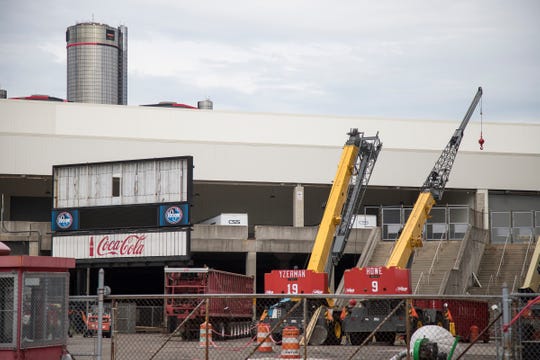
This article originally appeared in CAM Magazine
by Mary Kremposky McArdle
In hockey tradition, players collectively raise their hockey sticks in the air to celebrate each goal scored. JJ Curran Crane Company raised a stick of a different sort to successfully achieve the first-phase dismantling of the iconic Joe Louis Arena, affectionately known as The Joe to Detroit Red Wings’ fans. Working as a tight team, JJ Curran and HOMRICH efficiently removed approximately 3,400 exterior metal panels in a few short months beginning in late spring 2019. The stick – or actually sticks – of a different sort were primarily two 50-ton Grove rough terrain (RT600E) cranes, each with a main boom of 105 feet and a 56-foot jib.
HOMRICH prepped and JJ Curran Crane lowered each ribbon-like panel to the ground, revealing the steel “bones” and lower bowl of a building constructed over 38 years ago. Since 1979, the bowl had been home ice for the legends of Hockeytown, and the very place where Gordie Howe played his 23rd NHL All-Star Game and the hallowed arena where the Red Wings skated, battled and sweated to four Stanley Cup championships, two resulting in possession of the coveted Cup itself.
As ardent hockey fans, JJ Curran Crane wanted to honor the arena and its legendary players. JJ Curran’s Vice President of Finance Mike Coffman suggested “doing something special with the cranes that would be working at The Joe,” recalled JJ Curran Vice President of Sales and Operations Mark Wade. “I said, ‘Why don’t we wrap the counterweights to make them look like the retired jerseys hanging in the arena.”
To make it happen, the company wrapped massive red decals around the 11,600 lbs. counterweights of each crane red and showcased the names and team numbers of two Red Wing greats in white. One crane sports the name and number of Mr. Hockey himself – Gordie Howe and his famous No. 9 jersey – and the other honors Steve Yzerman, the long-serving team captain who wore No. 19.
These custom-wrapped cranes continue to work on construction sites throughout Detroit. “We decided not to take off the markings,” said Wade. “The cranes still go out on other jobs now as Gordie Howe and Steve Yzerman so to speak.”
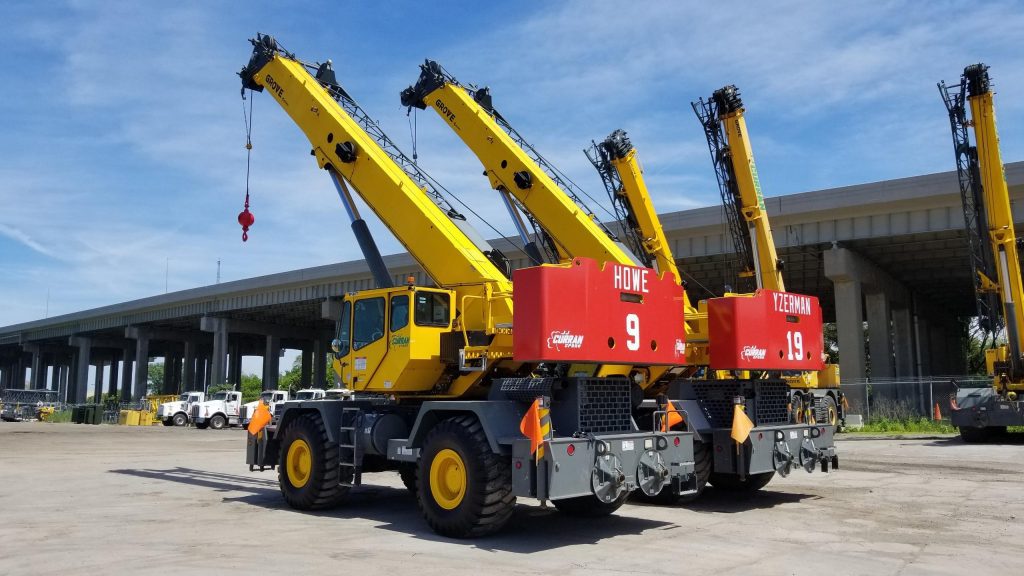
The Right Stuff
Founded in 1950, JJ Curran brought its 70-year knowledge base and its high level of concierge service to crane selection for The Joe. Project specifications originally called for a 30-ton rough terrain crane, but “we had two newer cranes in the 50-ton category in the yard that met all of the project parameters and were almost identical cranes to the 30-ton machines,” said Wade. And despite the upgrade, JJ Curran didn’t charge extra for the higher tonnage cranes, saving HOMRICH valuable dollars.
Given the 50-ton RT’s height, reach and capacity, the two selected cranes saved valuable time on the construction site as well. “Because the cranes could handle heavier weights and reach further out from the building surface, we didn’t have to move the crane as often,” Wade explained. “If we had used a smaller crane, we would have had to move the crane physically closer to the panel to allow it to pick the weight. With the 50-ton, we could be positioned further away, which allowed us to pick more panels before we had to move the crane. And it’s not that it takes a long time to move the crane – it might take an hour or two to re-position and set back up – but we knew it would save time over the course of several months and several thousand panels.”
HOMRICH Project Manager Tom Lantagne confirms the benefits of the 50-ton RT. “What the 50-ton did for us on this project was to improve on down time,” said Lantagne. “The additional reach was a help because we had to move the crane less. We were able to remove a few more panels with each set up compared to the 30-ton crane. It was especially helpful while we were working along Steve Yzerman Drive. We were setting the crane on an uneven surface in a tight area and the set-up time was longer than other areas.”
Beyond trimming cost and schedule, HOMRICH benefited from JJ Curran’s up-to-date fleet. JJ Curran’s 50-ton Grove RTs are 2014 models as opposed to the industry’s more commonly older models. “We pride ourselves in having the most updated fleet in the city,” Wade said.
Rounding out the crane selection, JJ Curran used a 30-ton rough terrain crane at The Joe as well. On one side of Joe Louis Arena, only an elevated deck separates The Joe from the TCF Center, formerly known as Cobo Center. “The 50-ton Groves are too heavy for the deck, so we used a smaller 30-ton Grove RT530E crane on that side of the building,” said Wade.
High Winds and High Volume
The primary obstacles in the field were Mother Nature, along with the variation and sheer number of panels slated for individual removal. “We encountered some high winds,” said Wade. “When you are working 105 feet up and pulling down panels that basically act like sails in the wind, we had to stop in order to work safe. We relied on HOMRICH to make the call, but basically we stopped when the winds reached about 20 to 25 miles an hour.”
In general, the ribbon-like panels measured roughly 25 feet long by 2 feet wide and weighed approximately 250 lbs. to 350 lbs. But not all panels were cookie-cutter. “As we went around the building, the panels changed in shape and size based on the contour of the building and the location of each panel group,” said Wade.
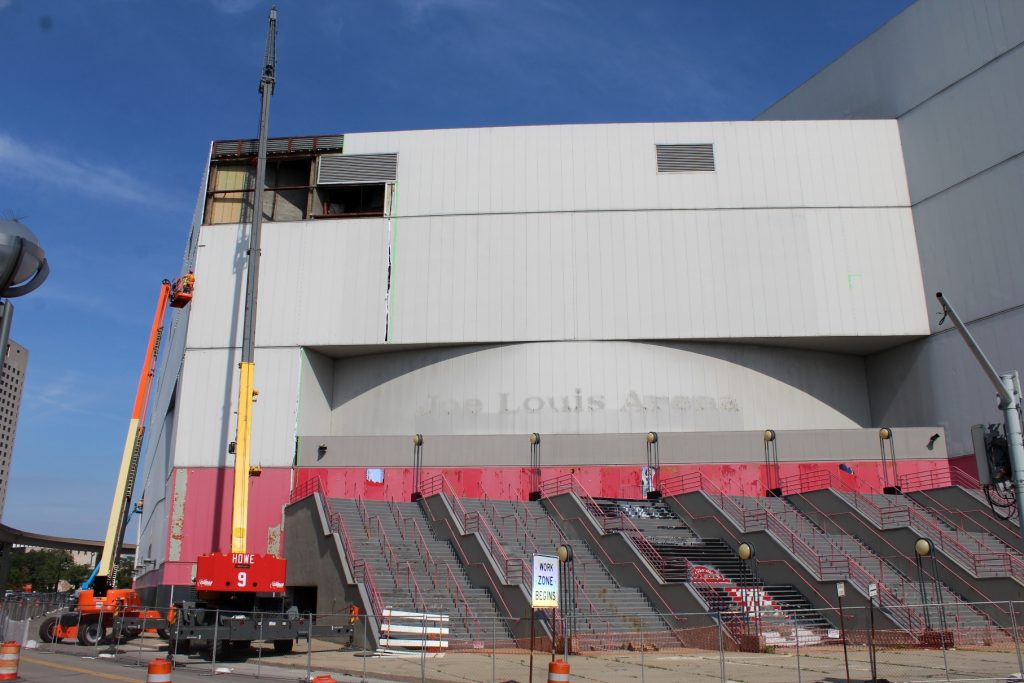
Planning a stream-lined flow of work successfully managed the challenge presented by the large volume of panels. “HOMRICH did an excellent job prepping the panels ahead of us, so we were not waiting on their work,” said Wade. “We worked very well with HOMRICH.”
HOMRICH’s prep work included cutting the panel seams on the wall. “The panels were seamed with sealant and glue, so HOMRICH had to cut the seams to get them ready for removal,” said Wade.
HOMRICH drilled holes in each panel – one at the top for the lift lugs and lift line, and one at the bottom for the tagline the ground crew uses to safely and easily guide the load. “We installed clips with self-tapping screws to attach the taglines,” said Lantagne. The next step: “After HOMRICH drilled the holes, we would swing a crane over, HOMRICH would attach the rigging to the panel, and our operator would lift it from the wall and lower it down,” Wade explained.
Faced with 3,400 individual panel lifts over the course of a few months motivated both firms to establish a proper pace for the project. At the beginning of the project, JJ Curran planned a calculated pause of several days before launching its own work. “We allowed HOMRICH to get ahead, because otherwise, we would just be sitting and waiting, and they would be paying for crane time that was not being used,” said Wade.
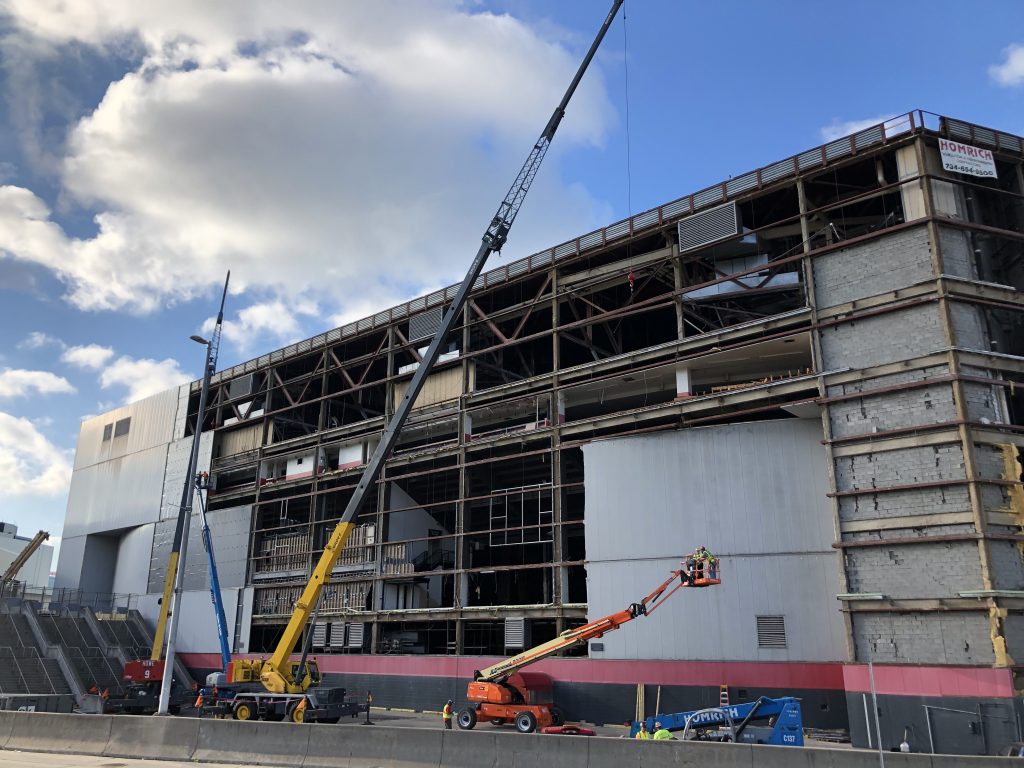
Having a consistent team aided the project as well. “Having the same crane operator on the site for the entire job helped,” said Wade. “Our operator became familiar with the pace of the work and became comfortable with the HOMRICH crew.” Adamo Group, Detroit, was the prime demolition contractor for the arena.
Lantagne commends JJ Curran’s expertise and its spirit of teamwork. “JJ Curran’s team does a good job with collaboration,” said Lantagne. “JJ Curran Sales Engineer Matt McVittie had been involved from the pre-planning through execution. I had Matt onsite multiple times to take a look at some of the more difficult picks and to make sure we had the right equipment onsite. The team at JJ Curran seems to really care that you have a successful project.”
TEam Detroit
As crane suppliers and operators, JJ Curran in a sense has been a part of the Red Wings team for decades. The Detroit-based company assisted in the construction of Joe Louis Arena in 1979, and participated in the construction of the Red Wing’s new home in Little Caesars Arena (LCA).
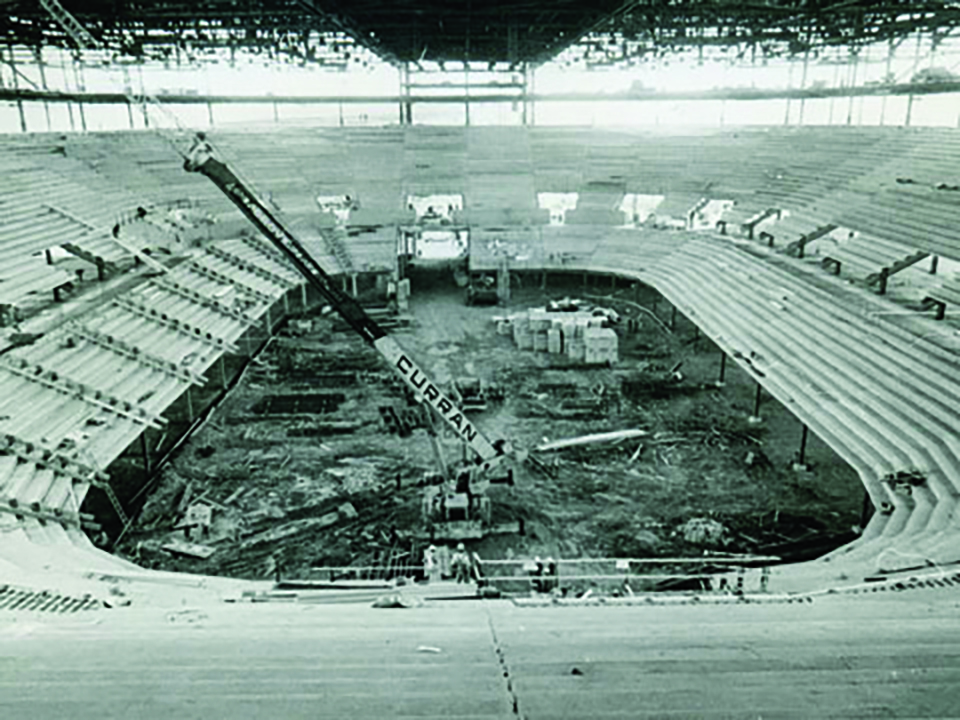
JJ Curran even played the same “position” at both arenas. “At Joe Louis, our cranes worked inside the arena to set all of the air chillers, ductwork and other components,” said Wade. “At LCA, we had an 80-ton RT working for over a year down on the ice level hoisting all the air-conditioning units and all of the scoreboards and videoboards into place.” The hoist was quite a feat given the fact that “the LCA scoreboard weighs 89,750 lbs. and ranks as the largest seamless center-hung scoreboard in the world,” according to Olympia Development.
JJ Curran Crane assisted in the revitalization of another landmark in Detroit’s sporting history. The company supplied and operated a Grove GMK6400 with MegaWing for The Corner, a four-story apartment complex built on part of the Tiger Stadium at Michigan and Trumbull. “Champion Home Builders constructed pre-fab or modular units, including carpet and full kitchens,” said Wade. “We lifted and stacked the sections into place, and they attached them together.”
A long-time fan of the Motor City itself, JJ Curran Crane has called Detroit home throughout its seven decades in the crane rental business. “We are proud of our longevity in the city,” said Wade. “We’ve been in Detroit from Day One. It’s exciting to see the city coming back and to be part of a group of contractors that are working to make Detroit better.”
JJ Curran’s Fleet Re-Invention and Expansion
JJ Curran Crane Company itself is undergoing an exciting expansion. Since its inception, the company has been known for its work in steel mills, refineries and in the heavy industrial arena in general. In fact, JJ Curran Crane literally shares a fence with the Marathon Oil refinery. “Our first job was at the Marathon refinery,” said Wade, “and we’ve been working with Marathon for decades as well as U.S. Steel and AK Steel.”
JJ Curran has been expanding beyond its bread-and-butter heavy industrial projects and continues to boost the diversity of its lifting equipment fleet, including sourcing crawler cranes – the primary anchor crane used on large projects for precast concrete and structural steel installation.
The company has even added tower cranes to the Detroit skyline. “I believe there hasn’t been a tower crane in Detroit since the construction of the Renaissance Center,” said Wade. “In just over the last few years, however, we’ve had two Liebherr 316 EC-H Litronic tower cranes in Detroit, one at the Campus Martius expansion in downtown Detroit and another on a project at Third Avenue and West Grand Boulevard near the Fisher Building.”
While JJ Curran typically owns all of its equipment, the company is currently working with several strategic partners in the tower crane marketplace rather than own this type of lifting equipment at this time. “We work with a firm called Morrow Equipment, the company with the largest tower crane fleet in North America,” said Wade. “Morrow rents the crane, but doesn’t assemble, operate or service it. As part of our concierge level of service, we provide a full turnkey operation, offering to assemble the crane, as well as maintain, operate and disassemble it.”
Whatever the crane or market niche, JJ Curran Crane Company has established a reputation for quality and professionalism. True to its roots, the company remains a family-owned and operated business in a city that has long served as its home. According to the firm’s own website, “At JJ Curran Crane Company, we owe everything to John J. (JJ) and Jacquelyn Curran—our founders and the proud parents of five Curran children. Their commitment to family and each other made it possible for JJ Curran to become a thriving business in metro Detroit” now for almost 70 years and counting.